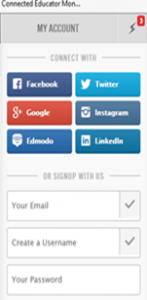I started this blog post with intention of sharing a nice resource for teachers to use creatively with their students. We regularly share new and exciting resources which provide opportunities for learning.
This resource’s added appeal was that a teacher could use it without signing up their students.
Sharing students personal information online is a current hot topic and this resource was the perfect resource to explore the issues.
I wish to state here and now I am not a lawyer, but an educator. I am looking at how I could use such resources and educate my students to use digital technologies safely and responsibly whilst meeting my obligation keep their personal information, well? …Private.
The Department of Education and Early Childhood Development (DEECD) outlines the need for schools to obtain consent to post any information online about a student or have their students do it in their care or under their instruction. http://www.education.vic.gov.au/about/programs/bullystoppers/Pages/lolconsent.aspx
Posting and sharing information about a person other than yourself online
or in any other way requires consent. Consent must be fully informed, freely
given, current and specific in how the information will be presented and to whom
it will be presented. Schools will require signed authority for any work, images
or information posted online. School should understand that while consent can be
freely given, it can also be withdrawn at any time. The school would then be
required to remove the content/resource immediately.
We all think of photos and student video, but sometimes we are sharing information that is not as obvious. It includes the personal information given to online services when we to sign up to applications – name, age, address, date of birth …. You know the drill.
When I looked at the resource I was able to do some things without signing up at all. To use the service fully I had to sign up, and so would my students.
“How can I get my students to use a great online service whilst meeting my obligations around Privacy legislation?”
The online resource gave me many options to sign up. I was presented with this familiar box above. Single sign on makes things easier and as an adult I use it almost without thinking. But what does it mean when I use it or I get my students to use it- in terms of sharing personal information and in some cases sharing the details of the “Friends, circles or details of others in their communities”?
I have taken these from the transition pages of each service informing me , or in some cases NOT informing me of what information I would be sharing.
By logging in with my Twitter account I was giving the following permission
This application will be able to:
- Read Tweets from your timeline.
- See who you follow, and follow new people.
- Update your profile.
- Post Tweets for you.
By signing up with Facebook I was giving permission to share the following info:
Your public profile and friend list. This does not let the app post to Facebook.
Choosing Google+ provided my email address.
No information was provided by Instagram about what they were sharing (not sure what that meant) but I was prompted for my username and password.
Edmodo gave me a link to not one but two pages outlining what would be shared and how. It was interesting to see changes at different age ranges https://support.edmodo.com/home#entries/27877390-edmodo-connect-log-in-with-edmodo , and
LinkedIn said NO you cant use us to sign up! Not too many children on LinkedIn.
At its worst I have seen services which raid your contacts list and take all of that information to use in their communities. It is never described as this but more like …. Connect with friends:-)
“Who I follow” and “Friends List” ???? Not so thrilled to have tweets posted for me thanks very much.
Just as we educate our students to use online tools and services we also need to educate them around the sharing of information from one service to another. We also need to make sure we have parents permission. Educating students to question what they are being asked for and share as little information as possible with these services is important.
So how would I choose to get my students access to this resource myself? After fully informing parents and getting their consent, I would get my students to sign up by using their school email address. Every DEECD school has one for their students already available. (Ask your school technician if you are unsure). The student email allows your students access but also allows you to teach your students how to manage their own online services and reset passwords etc.
Educating students to be creative, connected and collaborative online includes contemporary knowledge about how the online world works.
It is non-questioned practice for us to check out thoroughly the people who work in our schools eg Working with children checks. Checking out the online services we are taking our students to deserves equal attention. …. not to forget obtaining fully informed parental consent.
For DEECD schools requiring legal advice in this and related areas please contact: